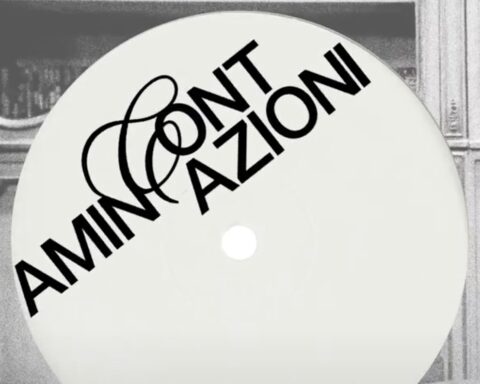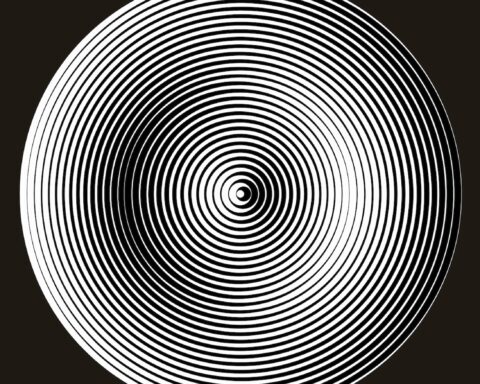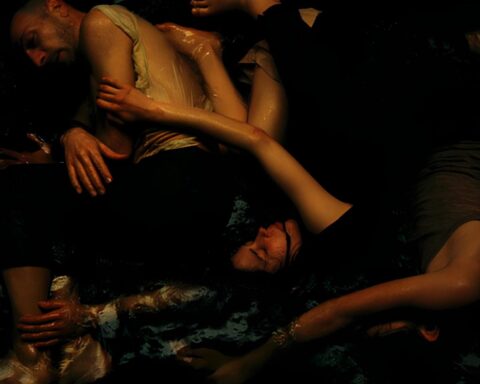An artist who has always been attracted by marginal dynamics and aesthetics, by the complex relationship between economy and contemporary landscape.
Born in Alba CN, in 2000 he moved to the Neapolitan hinterland where he began a work that investigates one of the most plastic and dynamic territories in Italy and draws a sort of map of informality. The margin is understood as a condition that is often more mental than geographical. Through the study of the margin, he activates a process dynamics which, applied to artistic research, allows the emergence of alternative aesthetics.

Marika Marchese: How was the site-specific “History Repeating” project for the Milan Stock Exchange born?
Eugenio Tibaldi: The History Repeating project is the story of a failure, a failure of capitalism but also of my own project.
I was asked to think of an exhibition for the Milan Stock Exchange, a reflection on the value and concepts of finance. I really didn’t really know anything about Quotes, Stocks and Operations so I decided to study and search for some data. These studies have fascinated me and they range from access to financial money of the various social groups to the social impact of financial operations on corporate capital, at the moment in which the symbol of money becomes part of the religious representation and assumes the role of the only common element in all world populations and finally to the concept of surplus-value. The final result was the design of a site-specific installation for the former scream room, which has a different use based on the social role of those who access it. A common use of the Milan Stock Exchange as entering from the ground floor he will find himself faced with a pile of daily waste of capitalism piled up and recreating compact walls that hide inside the living spaces similar to those of the people who live in the dumps of the world.
Above this heap and recreated and visible only from the executive offices of listed companies whose windows overlook the wonderful central hall, a grove with a mountain lake, a place of purity and wonder that lies down and takes shape on the residue of the capitalism and its relative failure. This installation has never been built, I’m afraid I have not understood the client’s requests. Thanks to these studies I have also begun to carry out reflections and studies on power and on how it has changed over the last 200 years in relation to information and law that have been useful for me to build the Democratization of the human defect series. I always like to see the growth aspect that also lurks in failure.
M.M.: In Democratization of the human defect series, you worked on 199 engravings made by Enrico Gonin in the mid-nineteenth century, on which you made interventions with brightly coloured watercolours, a series of dildos, arguing that power is enjoyment.
Enjoyment is the satisfaction of one’s drives as Žižek states. In the sense that “power is already always its transgression”. Could we interpret your work as “going beyond” the ordinary and beyond the banality of everyday life? In the meantime, why such a singular choice? (A book of 19th-century castle engravings) What does the Democratization of the human defect consist of?
E.T.: Gonin’s folder was created for the Savoy family, to offer the monarchical power also the visual and artistic side for its narration. In this historical moment talking about power is complicated, there are many requests for power that arise from the various minorities, but what I fear is that the defect is in the request. If you ask for rights it is one thing, but if you ask for power I fear that there is the will to replicate the same type of mistake made before us, to want to occupy our small castle and enjoy. From here comes the work, the monarchy had 199 castles, now I have separated and divided them for 199 possible minorities, tell me who and what you represent and you will have your castle and your…Dildo … With a small way out, it is only with a careful analysis of the tables, it is a small incision, a cut to go beyond, in addition to the defect that has characterized our entire recent history, perhaps emerging from the great narrative to open a new chapter in which the “cultural study” (as educated people would say) could be the way.

M.M.: Going even further, you have often moved, sometimes out of necessity, sometimes for work. You live in Turin, and you lived in this house to which you dedicated the Architecture of isolation project. You have dealt with various materials, from the seriality of collecting to the limits of disposophobia. Seeing this project of yours, I was able to reflect on the fact that we all live in psycho-geographical coordinates made of memories and objects, to which we give, as real fragments of that moment, a powerful emotional charge, such that we cannot free ourselves from them. not always. The need to have these objects in front of our eyes serves not only to remember but to define us, to reflect, in the sense of finding ourselves in that memory and in some way of reliving it. Objects tell about us, both in the occupied space and in the free space that remains, inside us and by analogy in the house.
E.T.: The Architecture of isolation was the project through which I was able to narrate my experience of the pandemic, closed at home and without the possibility of travelling for research, moving seemed to me the best way to not lose the aptitude for renewal. Moving is like a sort of therapy to rearrange my thoughts and not fossilize me. Luck made me come across the house of a historian who for the last 10 years of his life has never left the house and has accumulated objects, books and artifacts in an attempt to fill the void dictated by the voluntary refusal of civil society. I was faced with a marginal dynamic that I had never studied.
This condition has allowed me to look into the abyss that is possible for people (like me) who live a large percentage of life inside the mind. When the props of civilization collapse, social conventions break down, and then we stop wearing a mask of adaptation to reality and everything becomes pure perception. The confrontation or dialogue becomes imaginary and carried out with people who lived in different eras, the landscape is reduced to the objects that surround us, to the scenarios we build in the mind, to what lives in our memories and to what we accumulate.
The house becomes a kingdom of which we are the only inhabitant and absolute ruler, an empire of madness and perversion in which the passions that have animated our life are transformed into obsessions and become the only possible scenario.
Acquiring all the material in bulk and being able to study it first for months and then work it was like carrying out a core drilling in the most intimate marginality or the one imposed by the mind and building an exhibition that stands as a performative device for the visitor who is invited to perform a sort of personal journey of vision and reflection.
M.M.: Are there objects and projects that represent you more than others? Is there a part of your works that more than others is inspired by biographical facts? For example the house, as a recurring theme in your artistic practice.
E.T.: Each project made was fundamental, not a single research but an inevitable step to get to the next one. For this reason, I struggle to say which one represents me more, I believe that my research evolves and changes with me and represents the tensions that at a given moment presented themselves as urgency as something that seemed impossible to me not to do. This is why they have the gift of total momentary dedication and the train that they leave behind in subsequent projects. At this moment what I am concerned with is redefining the relationship that mankind has with power and with its aesthetic results, of how power is the prerogative of a few but the desire of almost everyone and that it often reveals itself in the perception of personal satisfaction, of revenge, more than in a real social aspect.
M.M.: You have analyzed the minimum housing unit, in relation to the living space of the homeless and not only, also in relation to the fact that the house is not only the place to return to but which represents us, comforts us, allows us to be who we are in an absolute sense. The house can be compared to our interiority that separates us and puts us in communication with the world. In Habitat01, the house becomes the edge of the human psyche, it is a mental space that becomes physical in which the natural element is transformed, becomes functional and hostile at the same time. A reflection on the different forms of transitory living.
Talking about home is also talking about its absence, its abandonment and its finding again. There is talk of familiarity, but also of uprooting and estrangement.
Inclusion, the image of these peripheral realities is returned to the human “territory”, giving identity to the actors, to the relationships, to the changes that occur continuously and which, through the inclusion of the different, are enriched, generating new aesthetic representations. Can you tell us how this project was born?
E.T.: Minimal Architecture is a project that has been with me since 2012 and is not yet completed, here too I investigate a bit of fear and potential drifts, in the shapes of the homes of the homeless I see the most basic form of architecture, the minimal sense of living. At the same time I imagine a warlike Cervantes against organized society in the positioning of the homeless (under the windows of multinationals or next to ATMs) I see a sort of silent warning to capitalism, a derailment which, in its being devoid of any organized form, however, it is a concrete witness of a shift.
The Habitat series, which began with the exhibition at the National Gallery in 2019, instead represents an aspect of reflection with respect to the inner house that we all build over time, a safe place, devoid of physicality but in which we can enter whenever we want and in any geography. The place where we hide the tools used to endure everyday life to feed the most romantic and the most vulgar aspects of our person. In short, a territory only ours in which terms such as right and wrong are emptied and the real ceases to have any meaning.


M.M.: All your work explores the relationship between space and the individual, as well as the perception we have of our environment and how this contributes to building our memory. You were immediately attracted to the suburbs, and from the very beginning of your artistic practice they become an important topic to study; real places of aggregation, but also peripheries understood as a mental category. How did you appropriate these moods? How did you experience them? What did you ask the population? Why did you choose to live in the suburbs?
E.T.: The periphery was one of the first dynamics I investigated, perhaps the most obvious of the concept of margin, which after more than 20 years I could define as my field of research. The margin is the place where I believe that change can take place, far from the spotlight and the perfection of the center, the “lateral” becomes the territory of mutation, so the best one through which to attempt a definition of the contemporary.
The only way I have found to be able to realize these narratives is to melt into the matter I want to deal with, to try to understand the dynamics that animate the territories, to live in the suburbs that I study, in the mental conditions that interest me, to investigate my own marginality and using my body and mind as a reactant. In the same way, narrating helps me to remove, translate and identify as elsewhere something that I know is part of me. I have never perceived the distance between the narrator and the narrated, I am similar to the margins that I tell but I delude myself that through these projects and the growth they allow me, I can continue to vary and escape a definition.
Walking in the places, savouring the often strong, acrid smells, feeling the sensations, building very tiring dialogues, makes the practice of knowledge very similar to that of everyday life. (You cannot talk about an artist if you don’t know his life, by Sabrina Vedovotto).
From the walk that leads adrift, to the discovery of the city suburbs, since we are often comparing the body to the house, we are trying to understand how the suburbs are the metaphor of a life that has lost its centrality, perhaps even lives on the margins.
M.M.: Can you tell us about Anthropogenic Herbarium? How was it born? Why a herbarium?
E.T.: There are two answers to this question and they are both true, one is that of the human being and the other is that of the researcher.
1) I painted the Herbarium during the first pandemic, I was in danger of going crazy and painting in a crazy and meticulous way gave me peace and filled my time. Moreover, not having understood anything of the very complex dynamics that move today in Addis Ababa, the mastery was also a declaration of surrender, badly I did some good works.
2) I worked as always following the aspect of perception, letting myself be guided by the alleys and emotions. The real was out of my reach and honestly I never really cared much. I perceived a sort of perennial tension of love-hate relationship between the anthropized element and the natural element present in Addis Ababa, so I imagined a design of the neighbourhoods and the city that follows the rules and shapes of some plants and not those of urban planning. Anthropogenic Herbarium is the son of a runaway time, a series of tables that hide a thousand doubts that the contact with Addis Abeba has unleashed in me. Some neighbourhoods were impossible to tell except by transforming them into something else.
I only try to build machines that trigger thoughts, fragile and imperfect machines in which it is impossible to separate the wonder from the disaster. These research-generated tools are activated in contact with the personal experience and cultural level of those who observe them and use them to make them a visual part of their personal history.
I always physically go through the places I am talking about, I live them and establish relationships that can be of collaboration or convenience, I almost always imagine the rest of my life in the place where I am at that precise moment, then for various reasons this does not has never happened, at least for now.
What I think I know is that the city I love doesn’t think of me. She is engaged in other and more important activities. I really like this not to be thought of, I have always searched for it in places, it makes me free to observe that I feel “not fundamental”, fallible. Generating fragile and precarious thoughts is difficult if you are constantly observed, but I really like feeling part of a flow that is not required to generate success and perfection.

M.M.: In Seaside, you went to untangle reason. You have brought to light some things, some details of distant lives, probably becoming the most obvious thing to do, in such a particular place. Can you tell us about this super-place that hosted you? How did he welcome you? Do you have special anecdotes?
E.T.: When I think back you have completed projects, I often reduce to anecdotes the intense and sometimes dramatic situations that determined the key points of the research. Reducing them to anecdotes means making them narratable, digestible, and that’s what I do even with some complex aspects of research. The most important works of the sea-side project are pop-ups, single-page books that open and through an apparently childlike technique tell very complex and articulated situations, stories of unease, illegality, abandonment and laxity.
My definition of some territories as “super-places” is important as it is in contrast with the definition of them as “non-places” by much of modern and contemporary culture, those who have lived in complex territories such as the peripheral ones know that transience of the visual schedule and of the humanity that determines it makes them fast, plastic and ruthless places where respect is a habit useful only to those who can afford it.
Home: home is for me the place where I feel protected, not in a physical sense. I have no idea of the house as a building, I think of the house that I experienced in some thoughts read in books, films, wine, music and flavours.
Roots/uprooting: these two terms cannot be detached and are both very important, they are useful only if we use them both. Knowing where we come from and who we are helped when we uproot ourselves when we put the most vulnerable part of ourselves on the line and try to redefine our own identity.
Transformation: transforming to life is not a weakness it is the key to evolution. If I could choose an animal, I would not want to be a lion or a shark, I would like to be a chameleon, capable of taking the tone of the place on which I rest my feet.







